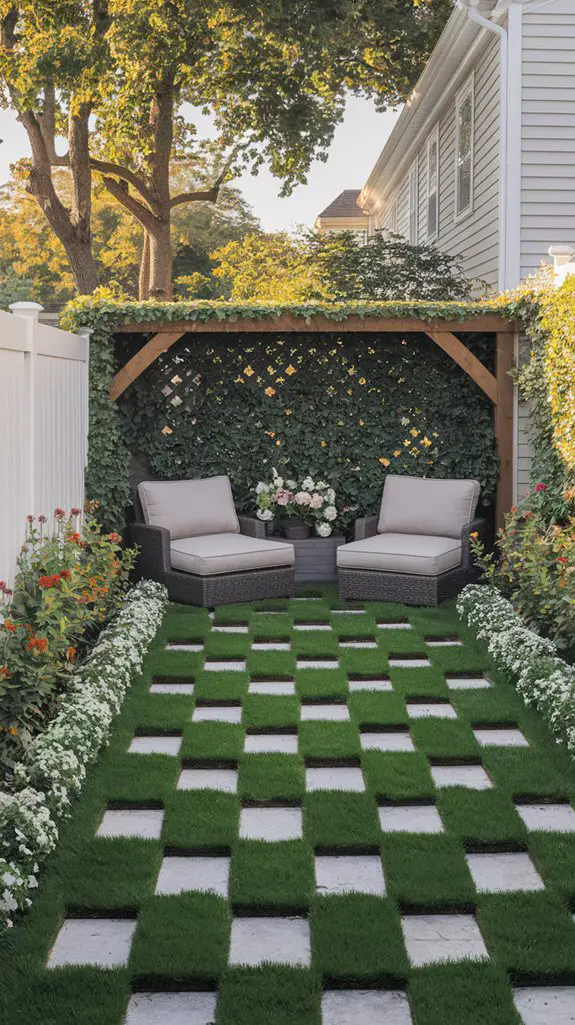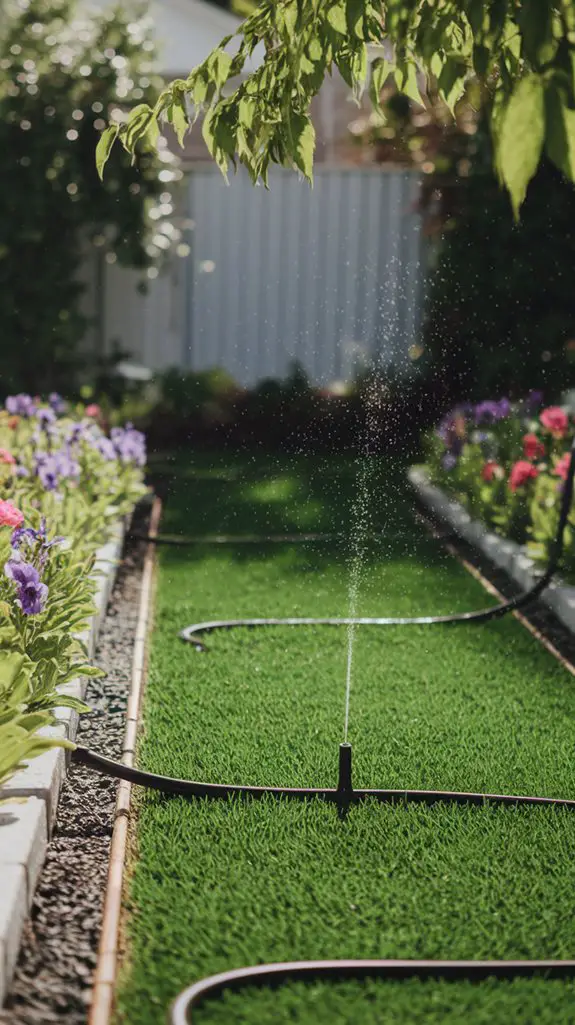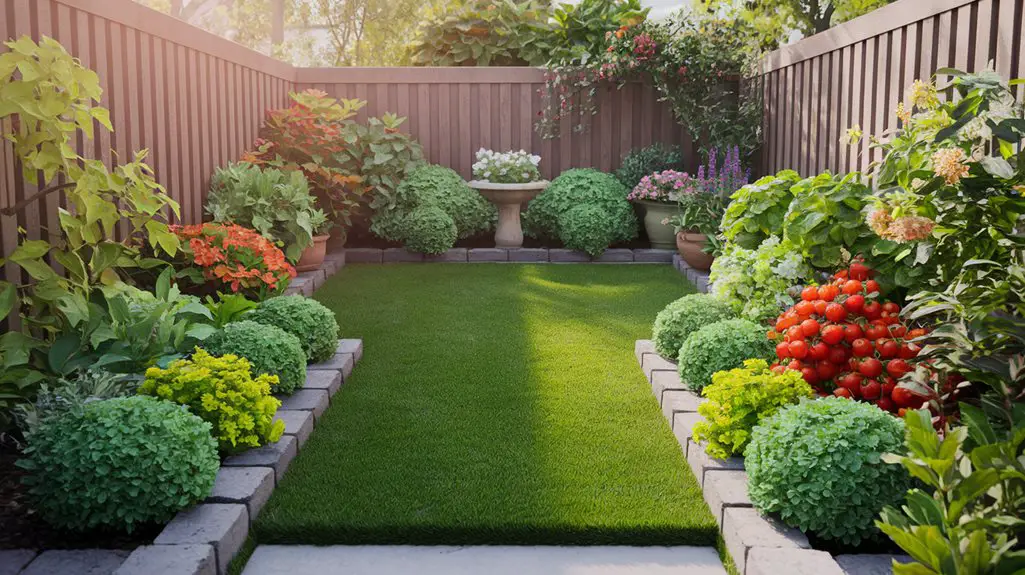Small spaces indeed demand specialized lawn care strategies, contrary to the assumption that they’re easier to maintain than larger yards. You’ll find that limited square footage actually requires more deliberate planning and technique to achieve that lush, verdant look. Your backyard’s size creates unique challenges with soil compaction, water runoff, and concentrated wear patterns—all of which can quickly deteriorate grass health. Let’s explore how tactical grass selection, strategic mowing, and efficient resource management transform these constraints into advantages.
Choose the Right Grass Varieties for Limited Spaces
Many homeowners with small backyards mistakenly select grass varieties that overwhelm their limited space. For compact areas, you’ll need species that thrive with minimal maintenance and slower growth patterns.
Consider fine fescues like Chewings or Hard Fescue, which require less mowing and tolerate partial shade. Zoysia grass offers excellent wear resistance while maintaining a compact growth habit. For warm climates, Bermuda ‘TifTuf’ provides drought tolerance with reduced vertical growth.
When selecting your lawn grass, evaluate your yard’s microclimate first. Measure daily sunlight hours, test soil drainage, and identify high-traffic zones. These factors determine which compact variety will succeed.
Don’t overlook dwarf cultivars specifically bred for small spaces. These specialized grasses require 30% less mowing while maintaining visual appeal and functional performance in restricted areas. Additionally, implementing effective lawn care tips can further enhance your lawn’s health and keep weeds at bay.
Maximize Impact With Strategic Mowing Patterns

When properly executed, strategic mowing patterns can transform your small lawn from an afterthought into a visual centerpiece. By alternating directions and creating deliberate patterns, you’ll enhance your lawn’s visual appeal while promoting healthier growth.
- Implement the classic stripe pattern by mowing in opposite directions on alternating passes.
- Create diamond patterns by mowing diagonally across your lawn, then repeating at 90° angles.
- Utilize a circular pattern working outward from a central point for dramatic visual impact.
- Change your mowing direction every 2-3 sessions to prevent soil compaction and grass leaning.
- Maintain ideal cutting height (2.5-3 inches) to prevent stress on grass roots.
Always use sharp blades and never remove more than one-third of the grass height in a single mowing session. Additionally, regularly mowing your lawn encourages lush green grass, as it promotes healthier growth and denser turf.
Space-Saving Irrigation Solutions for Small Lawns

Efficient irrigation presents a unique challenge in limited spaces where every square foot counts. Compact systems offer superior coverage without sacrificing your limited area. Choose micro-irrigation components that deliver water directly to root zones, minimizing waste and maximizing efficiency. Incorporating low-maintenance techniques can further enhance the sustainability of your irrigation strategy.
| Solution | Benefits | Space Savings | Cost | Complexity |
|---|---|---|---|---|
| Drip Lines | Targeted watering | High | Low-Medium | Low |
| Micro-Sprayers | Adjustable coverage | Medium | Medium | Medium |
| Smart Timers | Water only when needed | N/A | Medium-High | Medium |
| Soaker Hoses | No permanent fixtures | High | Low | Very Low |
| Rain Barrels | Utilizes vertical space | Medium | Low | Low |
Consider wall-mounted hose reels or underground systems to eliminate tripping hazards. Smart controllers allow precision scheduling based on weather conditions, further optimizing water usage while keeping your compact lawn lush.
Vertical Garden Elements to Complement Your Lawn
Vertical garden elements transform small backyards by maximizing unused vertical space while preserving your precious lawn area.
By implementing strategic vertical gardening techniques, you’ll create visual interest above ground level while maintaining functional turf below.
- Install trellises against fences or walls for climbing plants like jasmine or clematis.
- Mount tiered planters on exterior walls for cascading flowers or herbs.
- Integrate espalier fruit trees along boundaries for productive edible landscaping.
- Position living wall systems with built-in irrigation for dramatic plant displays.
- Suspend hanging planters from pergolas to frame lawn areas beneath.
When selecting vertical elements, make certain they receive appropriate sunlight exposure and won’t cast excessive shade on turf.
Choose drought-tolerant species for upper placements where watering proves challenging.
Incorporate automated drip systems to maintain ideal soil moisture in elevated containers.
Additionally, consider incorporating stunning vertical garden ideas to elevate the overall design of your outdoor space.
Seasonal Fertilization Schedule for Compact Yards
Just as your vertical elements enhance visual appeal, proper fertilization maintains your lawn’s health in limited spaces. Small yards require strategic nutrient management to prevent burned patches or excessive growth. Apply fertilizers at 50-75% of standard rates to prevent nutrient runoff. Additionally, incorporating eco-friendly practices can further enhance the vibrancy of your organic lawn.
| Season | Fertilizer Type | Application Rate | Primary Benefits |
|---|---|---|---|
| Spring | 20-5-10 slow-release | 2 lbs/1000 sq ft | Root establishment |
| Summer | 16-4-8 organic | 1.5 lbs/1000 sq ft | Heat resistance |
| Fall | 10-20-10 phosphorus-rich | 3 lbs/1000 sq ft | Winter hardiness |
| Winter | No fertilizer | Rest period | Recovery phase |
For compact yards, you’ll need precision spreaders rather than broadcast types. Always water thoroughly after application to activate nutrients while preventing chemical burns to delicate grass crowns.
Pest Control Techniques for High-Traffic Small Lawns
Small urban lawns face unique pest challenges due to their concentrated usage patterns and limited recovery zones.
You’ll need targeted strategies that protect both your grass and the people who enjoy it. Implement integrated pest management to minimize chemical applications while maximizing effectiveness.
- Apply diatomaceous earth around perimeters to create natural barriers against crawling insects.
- Introduce beneficial nematodes in early spring to control grub populations before they establish.
- Use targeted spot treatments rather than broadcast spraying to preserve beneficial insects.
- Install cedar mulch in garden edges to naturally repel ants and certain lawn-damaging beetles.
- Maintain ideal mowing height (3-3.5 inches) to enhance natural pest resistance through stronger root systems.
Regular monitoring is essential—inspect your lawn weekly during peak seasons to catch infestations before they spread throughout your limited space. Additionally, using natural pest control methods can further protect your garden while promoting a healthy ecosystem.
Conclusion
You’ve prioritized proper planning for your personal piece of paradise. Don’t delay diligent care—it’s the difference between mediocre and magnificent mini-lawns. Maintain mowing patterns, water wisely, and fertilize faithfully throughout the four seasons. Remember that small spaces shouldn’t sacrifice splendor; they’ll reward your regimen with robust resilience and remarkable results year-round. Your compact canvas can create considerable curb appeal with consistent care.




